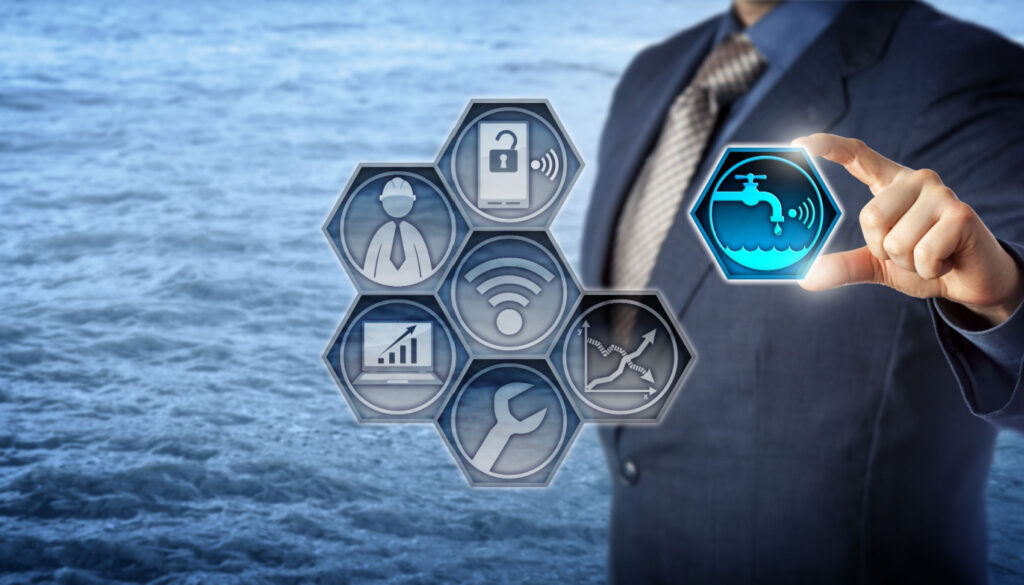Water management technologies have evolved dramatically since the days when listening sticks were about the only leak detection device available to utilities. And today, water management is about far more than leak detection. In fact, it’s no longer even about just water management; now it’s increasingly about data technologies and smart water management.
So, why is smart water management needed? And where is it going from here?
First steps toward smart water management
Utilities have long employed a variety of approaches to reduce water loss. Devices like simple listening sticks have been around for decades, as have billboards and radio advertisements urging consumers to call the water utility when they notice leaks or other problems. Periodic leak detection campaigns, in which teams scan different sections of the network on a preset schedule, is another common approach.
Those methods might have sufficed in the past, but today, many utilities understand that they need more advanced techniques that give them better visibility into what is happening in their underground network. In addition to reducing non-revenue water (NRW), they are looking to new technologies and processes to help them improve their operational efficiency and customer service.
Getting data is easy; getting insights from it is not
To this end, forward-thinking utilities are starting to establish district metered areas (DMA) and install digital water devices that generate data about conditions in the network, such as flow and pressure meters, fixed and mobile acoustic loggers, pressure transient sensors, water quality sensors, and pressure reducing valves (PRV).
Installing digital water devices is the first step in evolving toward smart water management. No utility should depend on just one type of technology, but rather each utility should combine multiple technologies according to the specific needs of the network. A utility in a densely built-up urban area (where fixing a leak could be challenging and expensive) might use methods for accurate leak detection and smaller DMAs, while a utility in a more rural area that covers a wider geographic area will get more value from pressure control and larger DMAs. Of course, environmental factors will make a huge difference too. Networks in hot and dry climates will likely need different approaches than those in colder and wetter regions.
The data generated by the various devices and systems can be processed and analyzed to extract insights about network conditions, leaks and other sources of NRW that can guide proactive repairs and maintenance. But the huge amount of data that is generated makes the ‘understanding’ process very complex – the more devices and systems, the more data, and the more difficult it is to extract insights. Therefore, advanced analytics tools and methods are needed to identify trends and generate visibility.
The missing piece: smart integration
While the various digital water systems typically offer some analytics, each one employs its own methodology tailored for the specific type of data. As a result, insights about different aspects of the network are siloed in different systems.
When there is one system for flow or customer usage data, another screen for acoustic logger data and yet another for satellite detection, it’s impossible to get a single comprehensive representation of the network status. It still takes multiple manual steps to detect leaks and other incidents, and to prioritize repair and maintenance activities – a process that is time-consuming and prone to error and inconsistencies. The siloed insights and convoluted processes also make it extremely difficult to dynamically re-prioritize activities as situations change. And, as more sensors and other devices are added, it becomes harder and harder to handle the huge and ever-increasing volumes of data generated across the network.
This brings us to the final crucial step utilities need to gain the effective visibility and control of their network that they are aiming for: integration. It’s vital to bring together the insights from the multiple different technologies and systems into a single platform where they can all be viewed together via one dashboard, one point of truth.
In short, integration of data as well as of the insights from multiple sources and systems is what turns water management into smart water management.
The value of smart water management
Integrating insights from the various systems and presenting them via a single portal or dashboard increases the reliability of the insights. When an alert generated by one system is complemented by insights from other systems, operators can be confident the alert is real, and set the appropriate priority.
With the ability to monitor all alerts through a single solution, control room personnel can work more effectively and efficiently. They can prioritize leak reduction activities better, improve incident response and confidently make dynamic operational decisions. The result: resource and financial savings, along with improved customer experience and interactions.
Smart water management can also play a significant role in creating a more sustainable future, helping utilities alleviate the effects of water scarcity and develop strategies to mitigate the effects of climate change. For example, as the water sector is the biggest consumer of electricity globally, driving down water loss can significantly reduce energy consumption – all the more vital wherever electricity is generated mostly by fossil fuels.
Smart water management at KUB
| Knoxville Utilities Board (KUB), which provides water, wastewater, electric and gas services to the city of Knoxville, Tennessee, is seeing significant value from smart water management technologies and methodologies. It has integrated TaKaDu Central Event Management (CEM) with information from its IBM Maximo work orders application and from its vast Advanced Metering Infrastructure (AMI) network. By cross-referencing the information from multiple sources and solutions, operators make better decisions about their response to each water loss event detected by TaKaDu CEM. Prior to integrating these solutions, every time the TaKaDu CEM detected an event, operators would toggle between multiple unconnected systems or consult co-workers, trying to understand the event. The process was inconvenient, error-prone, and slow. Now, through the work order information, operators can immediately see if field teams were working in the area around the time of a CEM-detected water event, making it easier and faster to determine which events are real leaks. The integration of residential water consumption information gathered by AMIs with TaKaDu CEM information provides operators with an always-available comparison between the water supply and consumption over time. Now, when TaKaDu CEM detects a water loss event, the additional visibility into consumption helps operators distinguish water loss due to leaks, unauthorized consumption, normal or outstanding consumption. |
Looking ahead: More digital water technologies = more data
Despite being a traditionally conservative and slow-moving industry, the pace of technology innovation and adoption in the water industry is accelerating. Diverse new digital water technologies, telemetry and devices are already becoming available. These include automatic metering infrastructure (AMI), IoT water management technologies and devices, water quality sensors for turbidity or chlorine and others. It’s certain that more technologies will be added in the coming few years. As new types of sensors are introduced and the price of the new technologies come down, both the variety of sensors and the sheer numbers installed will rise rapidly, driving a parallel rise in the amount of data that needs to be analyzed and integrated prior to being used to generate insights for daily decision making.
We’ve seen it happen in other industries, from manufacturing to energy and power: as digital solutions become available, the use of IoT-enabled solutions expands. And the amount of data explodes. Today, utilities with digital water devices are struggling with a flood of data. Tomorrow it will be a ‘data tsunami’.
The next evolution: holistic smart water management
As the data tsunami gains strength, utilities will need to deepen the integration of multiple systems and all the data sources and take a more holistic approach to smart water management. Along with technically integrating data and information from disparate sources into a centralized, intelligent analytics platform, water utilities will need to be able to seamlessly integrate insights and create a simple visibility dashboard.




